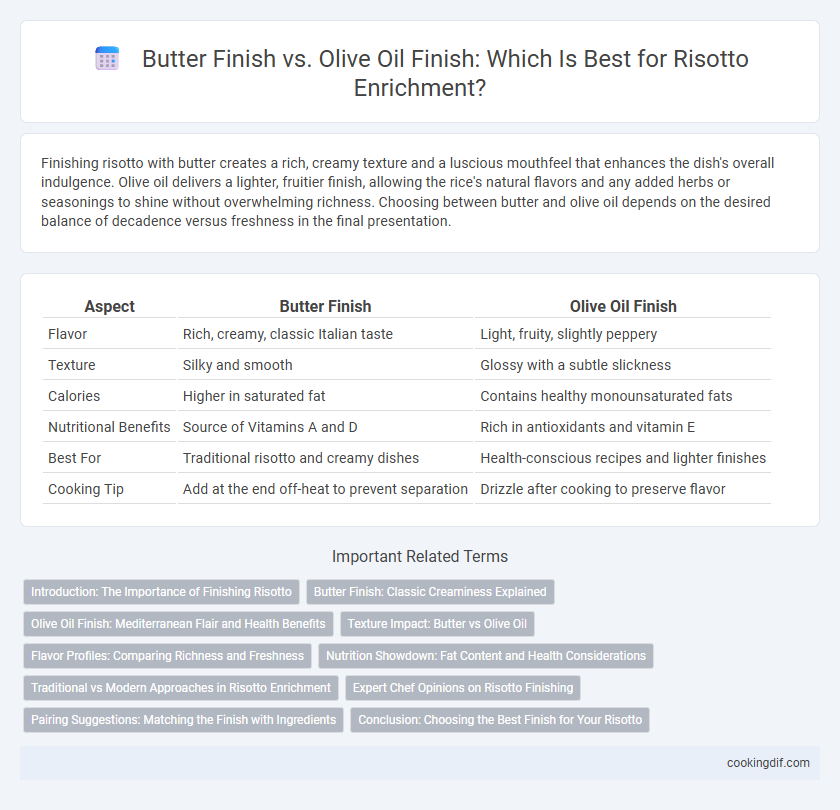Finishing risotto with butter creates a rich, creamy texture and a luscious mouthfeel that enhances the dish's overall indulgence. Olive oil delivers a lighter, fruitier finish, allowing the rice's natural flavors and any added herbs or seasonings to shine without overwhelming richness. Choosing between butter and olive oil depends on the desired balance of decadence versus freshness in the final presentation.
Table of Comparison
| Aspect | Butter Finish | Olive Oil Finish |
|---|---|---|
| Flavor | Rich, creamy, classic Italian taste | Light, fruity, slightly peppery |
| Texture | Silky and smooth | Glossy with a subtle slickness |
| Calories | Higher in saturated fat | Contains healthy monounsaturated fats |
| Nutritional Benefits | Source of Vitamins A and D | Rich in antioxidants and vitamin E |
| Best For | Traditional risotto and creamy dishes | Health-conscious recipes and lighter finishes |
| Cooking Tip | Add at the end off-heat to prevent separation | Drizzle after cooking to preserve flavor |
Introduction: The Importance of Finishing Risotto
Finishing risotto with butter creates a rich, creamy texture and enhances the dish's velvety mouthfeel by adding fat and gloss. Olive oil finish adds a lighter, fruitier note and subtle herbal complexity while contributing to a smooth, silky consistency. Choosing between butter and olive oil impacts the flavor profile and richness, highlighting the importance of the finishing touch in perfecting risotto.
Butter Finish: Classic Creaminess Explained
Butter finish in risotto creates a classic creamy texture by enriching the dish with smooth, velvety fat that melts into the rice, enhancing both flavor and mouthfeel. It binds the starch released from the Arborio or Carnaroli rice, resulting in a luscious, glossy sheen that defines traditional risotto. This method highlights the rich, buttery notes that perfectly complement the subtle sweetness of the cooked rice and any accompanying ingredients.
Olive Oil Finish: Mediterranean Flair and Health Benefits
Finishing risotto with olive oil imparts a distinctive Mediterranean flair characterized by fruity, peppery notes that complement the creamy texture. Rich in heart-healthy monounsaturated fats and antioxidants, olive oil enhances nutritional value while promoting cardiovascular benefits. The aromatic quality of extra virgin olive oil elevates the dish's flavor profile, adding depth without overpowering the traditional ingredients.
Texture Impact: Butter vs Olive Oil
Butter finish in risotto creates a rich, creamy texture due to its high fat content and slow melting properties, resulting in a smoother mouthfeel and glossy appearance. Olive oil finish imparts a lighter, silkier texture with a subtle fruitiness, enhancing the rice's natural bite without overwhelming its structure. Choosing butter enhances the luxurious body of the dish, while olive oil preserves a more delicate, refined texture with a slightly firmer grain.
Flavor Profiles: Comparing Richness and Freshness
Butter finish imparts a rich, creamy texture and a slightly nutty flavor that enhances the risotto's depth and smoothness. Olive oil finish provides a lighter, fruitier note with fresh, grassy undertones that brighten the dish without overwhelming the delicate rice texture. Choosing butter enriches the risotto's savory complexity, while olive oil maintains freshness and adds subtle aromatic lift.
Nutrition Showdown: Fat Content and Health Considerations
Butter finish in risotto adds saturated fats and fat-soluble vitamins like A and E but increases calorie density and may impact heart health if consumed excessively. Olive oil finish contributes monounsaturated fats, known for their heart-healthy benefits and anti-inflammatory properties, making it a nutritionally lighter option. Choosing between butter and olive oil depends on balancing flavor preferences with dietary goals focusing on fat type and overall nutritional impact.
Traditional vs Modern Approaches in Risotto Enrichment
Traditional risotto recipes typically employ a butter finish, known as "mantecatura," to create a creamy, rich texture and enhance the dish's velvety mouthfeel. Modern approaches often favor olive oil finishes, highlighting lighter, fruitier flavors while aligning with contemporary health-conscious trends and Mediterranean culinary influences. The choice between butter and olive oil directly impacts risotto's flavor profile and texture, balancing authenticity with innovation in Italian cooking.
Expert Chef Opinions on Risotto Finishing
Expert chefs emphasize that finishing risotto with butter enhances its creamy texture and imparts a rich, velvety mouthfeel, elevating the dish's luxurious appeal. Olive oil finish lends a lighter, fruitier note, preserving the delicate flavors and adding a subtle aromatic complexity favored in lighter or vegetable-based risottos. The choice between butter and olive oil finishing depends on the desired richness, flavor profile, and regional authenticity chefs aim to achieve.
Pairing Suggestions: Matching the Finish with Ingredients
Butter finish in risotto creates a rich, creamy texture ideal for pairing with earthy mushrooms, aged Parmesan, and truffle oil, enhancing luxurious flavors. Olive oil finish offers a lighter, fruitier note that complements vibrant ingredients like roasted vegetables, fresh herbs, and seafood, preserving brightness and subtlety. Selecting butter or olive oil for finishing depends on the intended flavor profile and ingredient harmony in the final dish.
Conclusion: Choosing the Best Finish for Your Risotto
Butter finish provides a rich, creamy texture and enhances the traditional flavor profile of risotto with its smooth, velvety richness. Olive oil finish lends a lighter, slightly fruity note while offering a healthier alternative with beneficial monounsaturated fats. The best finish depends on personal preference and dietary goals, with butter ideal for indulgence and olive oil suited for a lighter, heart-healthy option.
Butter Finish vs Olive Oil Finish for final enrichment Infographic

 cookingdif.com
cookingdif.com